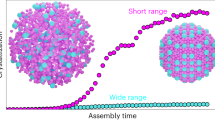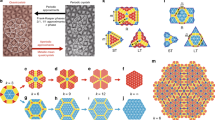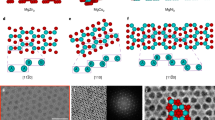Abstract
The discovery of quasicrystals in 1984 changed our view of ordered solids as periodic structures1,2 and introduced new long-range-ordered phases lacking any translational symmetry3,4,5. Quasicrystals permit symmetry operations forbidden in classical crystallography, for example five-, eight-, ten- and 12-fold rotations, yet have sharp diffraction peaks. Intermetallic compounds have been observed to form both metastable and energetically stabilized quasicrystals1,3,5; quasicrystalline order has also been reported for the tantalum telluride phase with an approximate Ta1.6Te composition6. Later, quasicrystals were discovered in soft matter, namely supramolecular structures of organic dendrimers7 and tri-block copolymers8, and micrometre-sized colloidal spheres have been arranged into quasicrystalline arrays by using intense laser beams that create quasi-periodic optical standing-wave patterns9. Here we show that colloidal inorganic nanoparticles can self-assemble into binary aperiodic superlattices. We observe formation of assemblies with dodecagonal quasicrystalline order in different binary nanoparticle systems: 13.4-nm Fe2O3 and 5-nm Au nanocrystals, 12.6-nm Fe3O4 and 4.7-nm Au nanocrystals, and 9-nm PbS and 3-nm Pd nanocrystals. Such compositional flexibility indicates that the formation of quasicrystalline nanoparticle assemblies does not require a unique combination of interparticle interactions, but is a general sphere-packing phenomenon governed by the entropy and simple interparticle potentials. We also find that dodecagonal quasicrystalline superlattices can form low-defect interfaces with ordinary crystalline binary superlattices, using fragments of (33.42) Archimedean tiling as the ‘wetting layer’ between the periodic and aperiodic phases.
This is a preview of subscription content, access via your institution
Access options
Subscribe to this journal
Receive 51 print issues and online access
$199.00 per year
only $3.90 per issue
Buy this article
- Purchase on Springer Link
- Instant access to full article PDF
Prices may be subject to local taxes which are calculated during checkout



Similar content being viewed by others
References
Shechtman, D., Blech, I., Gratias, D. & Cahn, J. W. Metallic phase with long-range orientational order and no translational symmetry. Phys. Rev. Lett. 53, 1951–1953 (1984)
Levine, D. & Steinhardt, P. J. Quasicrystals: a new class of ordered structures. Phys. Rev. Lett. 53, 2477–2480 (1984)
DiVincenzo, D. P. & Steinhardt, P. J. (eds). Quasicrystals: The State of the Art 2nd edn (World Scientific, 1999)
Keys, A. S. & Glotzer, S. C. How do quasicrystals grow? Phys. Rev. Lett. 99, 235503 (2007)
Abe, E., Yan, Y. & Pennycook, S. J. Quasicrystals as cluster aggregates. Nature Mater. 3, 759–767 (2004)
Conrad, M., Krumeich, F. & Harbrecht, B. A dodecagonal quasicrystalline chalcogenide. Angew. Chem. Int. Ed. 37, 1383–1386 (1998)
Zeng, X. et al. Supramolecular dendritic liquid quasicrystals. Nature 428, 157–160 (2004)
Hayashida, K., Dotera, T., Takano, A. & Matsushita, Y. Polymeric quasicrystal: mesoscopic quasicrystalline tiling in ABC star polymers. Phys. Rev. Lett. 98, 195502 (2007)
Mikhael, J., Roth, J., Helden, L. & Bechinger, C. Archimedean-like tiling on decagonal quasicrystalline surfaces. Nature 454, 501–504 (2008)
Murray, C. B., Kagan, C. R. & Bawendi, M. G. Synthesis and characterization of monodisperse nanocrystals and close-packed nanocrystal assemblies. Annu. Rev. Mater. Sci. 30, 545–610 (2000)
Shevchenko, E. V., Talapin, D. V., Kotov, N. A., O’Brien, S. & Murray, C. B. Structural diversity in binary nanoparticle superlattices. Nature 439, 55–59 (2006)
Eldridge, M. D., Madden, P. A. & Frenkel, D. Entropy-driven formation of a superlattice in a hard-sphere binary mixture. Nature 365, 35–37 (1993)
Shevchenko, E. V., Talapin, D. V., Murray, C. B. & O’Brien, S. Structural characterization of self-assembled multifunctional binary nanoparticle superlattices. J. Am. Chem. Soc. 128, 3620–3637 (2006)
Leunissen, M. E. et al. Ionic colloidal crystals of oppositely charged particles. Nature 437, 235–240 (2005)
Kalsin, A. M. et al. Electrostatic self-assembly of binary nanoparticle crystals with a diamond-like lattice. Science 312, 420–424 (2006)
Grünbaum, B. & Shephard, G. C. Tilings and Patterns (Freeman, 1986)
Ueda, K., Dotera, T. & Gemma, T. Photonic band structure calculations of two-dimensional Archimedean tiling patterns. Phys. Rev. B 75, 195122 (2007)
Frank, F. C. & Kasper, J. S. Complex alloy structures regarded as sphere packing. II. Analysis and classification of representative structures. Acta Crystallogr. 12, 483–499 (1959)
Sopousek, J. & Kruml, K. Sigma-phase equilibrium and nucleation in Fe–Cr–Ni alloys at high temperature. Scripta Mater. 35, 689–693 (1996)
Widom, M. Bethe ansatz solution of the square-triangle random tiling model. Phys. Rev. Lett. 70, 2094–2097 (1993)
Oxborrow, M. & Henley, C. L. Random square-triangle tilings: a model for twelve fold-symmetric quasicrystals. Phys. Rev. B 48, 6966–6998 (1993)
Leung, P. W., Henley, C. L. & Chester, G. V. Dodecagonal order in a two-dimensional Lennard-Jones system. Phys. Rev. B 39, 446–458 (1989)
Ishimasa, T., Nissen, H.-U. & Fukano, Y. New ordered state between crystalline and amorphous in Ni-Cr particles. Phys. Rev. Lett. 55, 511–513 (1985)
Glotzer, S. C. & Keys, A. S. A tale of two tilings. Nature 454, 420–421 (2008)
Chen, Z. & O’Brien, S. Structure direction of II-VI semiconductor quantum dot binary nanoparticle superlattices by tuning radius ratio. ACS Nano 2, 1219–1229 (2008)
Joseph, D. & Elser, V. A model of quasicrystal growth. Phys. Rev. Lett. 79, 1066–1069 (1997)
Zoorob, M. E., Charlton, M. D. B., Parker, G. J., Baumberg, J. J. & Netti, M. C. Complete photonic bandgaps in 12-fold symmetric quasicrystals. Nature 404, 740–743 (2000)
Hyeon, T., Lee, S. S., Park, J., Chung, Y. & Na, H. B. Synthesis of highly crystalline and monodisperse maghemite nanocrystallites without a size-selection process. J. Am. Chem. Soc. 123, 12798–12801 (2001)
Hines, M. A. & Scholes, G. D. Colloidal PbS nanocrystals with size-tunable near-infrared emission: observation of post-synthesis self-narrowing of the particle size distribution. Adv. Mater. 15, 1844–1849 (2003)
Park, J. et al. Ultra-large-scale syntheses of monodisperse nanocrystals. Nature Mater. 3, 891–895 (2004)
Acknowledgements
We thank S. O’Brien, W. Heiss, A. P. Alivisatos, T. Witten, W. Green and J. Urban for discussions and V. Altoe for help with analytical TEM studies. D.V.T. acknowledges support from the US National Science Foundation (NSF) CAREER Program under award number DMR-0847535 and the NSF MRSEC Program under award number DMR-0213745. M.I.B. acknowledges financial support from the Austrian Nanoinitiative. The work at the Center for Nanoscale Materials, Argonne National Laboratory, was supported by the US Department of Energy under contract number DE-AC02-06CH11357.
Author Contributions E.V.S. carried out experimental studies of the Fe2O3–Au nanoparticle system, M.I.B. studied the PbS–Pd system and X.Y. and J.C. studied the Fe3O4–Au system. D.V.T. analysed the experimental data. D.V.T. and C.B.M initiated and supervised the work. D.V.T and E.V.S. wrote the paper. All authors discussed the results and commented on the manuscript.
Author information
Authors and Affiliations
Corresponding authors
Supplementary information
Supplementary Information
This file contains Supplementary Notes, and Supplementary Figures 1-9 with Legends. (PDF 6541 kb)
Rights and permissions
About this article
Cite this article
Talapin, D., Shevchenko, E., Bodnarchuk, M. et al. Quasicrystalline order in self-assembled binary nanoparticle superlattices. Nature 461, 964–967 (2009). https://doi.org/10.1038/nature08439
Received:
Accepted:
Issue Date:
DOI: https://doi.org/10.1038/nature08439
This article is cited by
-
Colloidal quasicrystals engineered with DNA
Nature Materials (2024)
-
Quasi-crystalline order in vibrating granular matter
Nature Physics (2024)
-
Building blocks of order: block copolymer micelles and colloidal particles in complex packing structures
Journal of Polymer Research (2024)
-
A columnar liquid quasicrystal with a honeycomb structure that consists of triangular, square and trapezoidal cells
Nature Chemistry (2023)
-
Structural studies of local environments in high-symmetry quasicrystals
Scientific Reports (2023)
Comments
By submitting a comment you agree to abide by our Terms and Community Guidelines. If you find something abusive or that does not comply with our terms or guidelines please flag it as inappropriate.



